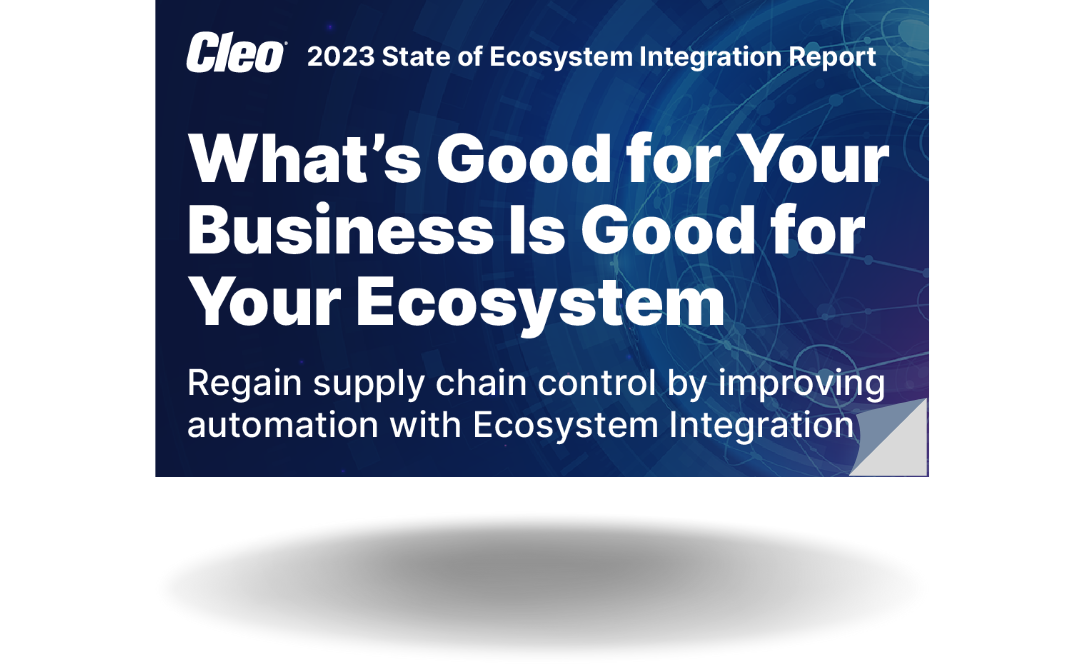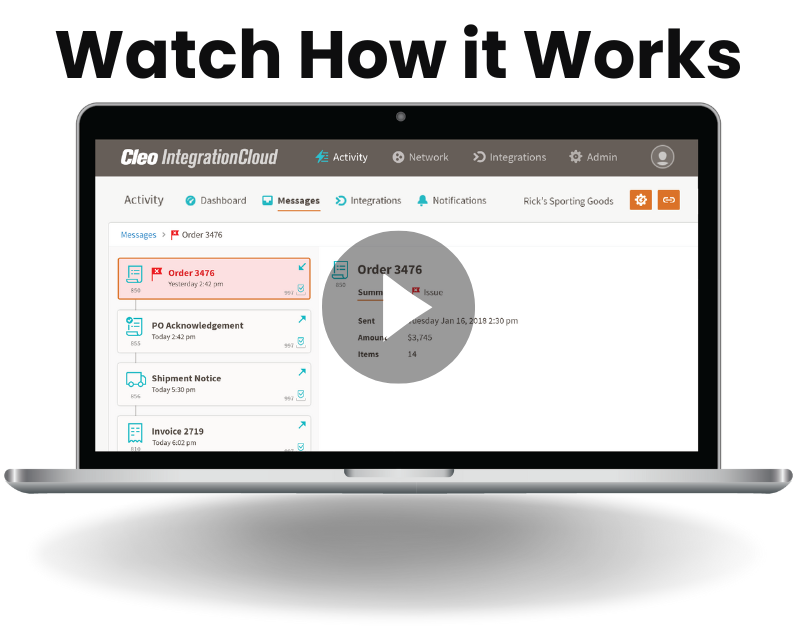Best Practices for B2B EDI Integration in 2024

In 2024, EDI will still be evolving quickly. EDI integration is becoming increasingly vital for organizations across a wide range of industries, especially those seeing more control over their solutions for ecosystem enablement. Businesses can gain a lot by locating and adopting the ideal solution, including:
- Accelerating / automating business cycles
- Lowering transaction failures
- Reducing total cost of ownership
Businesses need seamless interactions, and in the context of global supply chains, slowing communications can be catastrophic.
What is EDI?
Electronic data interchange (EDI) is the most common B2B E-commerce technology in use today. It is the electronic exchange of business documents (like purchase orders, invoices, etc.) between different computer systems and applications using a standardized format. Businesses involved with EDI (logistics, manufacturing, wholesale, etc.) must be as tightly integrated with one another as possible in order to gain the advantages of EDI.
There are now, thankfully, more advanced EDI integration solutions. This includes the cloud-based, managed EDI service model used by Cleo.
Here, we'll look into EDI as it currently exists and the best practices that can guarantee inclusive integrations that enable organizations to benefit to the fullest.
Companies rely on EDI to greatly improve the efficiency of business processes, leading to happier customers, better relationships, greater data and information accuracy, and increased revenue.
So whether your company is planning on implementing the technology for the first time, or you are looking to optimize the EDI technology that you already have in place, keep reading to find out some of the best practices for B2B EDI integrations in 2023.
Traditional EDI Integration (EDI VAN vs Point-to-Point)
Since its debut, EDI integration has been improving supply chains and their processes. Before we dive into best practices, it is important to differentiate between the two most common subdivisions of EDI; point-to-point and VAN.
Point-to-Point EDI
The popularity of point-to-point EDI, also known as direct EDI, is largely due to Walmart's adoption of the technology. In general, point-to-point EDI is frequently utilized by larger organizations that process a high volume of transactions.
With point-to-point EDI, connections are made directly between two organizations. So an organization with point-to-point EDI will have individual connections with each of its trading partners. Once a connection is made between two parties, the organizations must agree on an EDI protocol to use before they can start communicating.
When it comes to costs, companies are not charged for each document sent/received like they are with EDI VAN. Instead, companies often pay a fee when setting up a new connection with a trading partner. Associated costs include mapping fees, translation software, hardware, maintenance, etc.
The advantages of point-to-point EDI include greater control for businesses and it is considered one of the most secure methods of EDI communication.
On the downside though, point-to-point EDI can be complex due to managing individual connections for each trading partner. Furthermore, companies need to be able to support a wide variety of protocols to ensure they do not miss out on business opportunities. This is because if a trading partner wants to use a specific protocol that a company does not support, the two organizations will not be able to conduct business together.
EDI VAN
Another popular option is EDI VAN. EDI VANs were especially popular a few decades ago, but have since become more old-fashioned compared to newer solutions. However, many companies still utilize the technology.
When it comes to EDI VANs, all communication between two organizations goes through a third party. This third party is known as a value added network (VAN). With VANs, companies can use whichever EDI protocol they desire (each party can use a different protocol and do not have to agree on the same one), as long as they are using the same EDI VAN. This is because the VAN translates the documents into whichever protocol the receiving party utilizes.
When it comes to expenses, companies often experience lower upfront costs when implementing EDI VANs compared to point-to-point EDI. However, VANs often charge for each document sent, so larger organizations that send hundreds and thousands of documents per day can incur significant costs. Some VAN providers are now offering customers the ability to pay a flat-rate fee depending on their number of trading partners.
The advantages of VANs include only having to manage one connection, which is to the EDI VAN. This is because all communication with trading partners first flows through the VAN, so no direct/individual connections between partners are necessary.
Disadvantages include the technology becoming more outdated, less efficient, and less cost-effective as significant advancements in EDI technology continue to roll out. There is also the common issue of lack of direct visibility and control, given the role of the third party.
Web EDI: Making EDI Accessible to Non-Experts
As great as point-to-point EDI and EDI VANs are, there is a common obstacle when dealing with either technology: The learning curve. The learning curve is not only present for an organization, but for all its trading partners as well.
One alternative option that addresses this concern is Web EDI. Web EDI is a newer option that allows companies to harness EDI with little to no background or experience needed. Web EDI is a web portal that enables users to manually enter information and data. This information is then dispatched through EDI.
Frequently used alongside an EDI VAN, Web EDI offers advantages such as:
— Simplified supply chains
— Real-time data and information
— Partially automated B2B documents
— User-friendliness
The user-friendliness and simplification that Web EDI offers users and companies cannot be understated. For example, if a company is working with a new trading partner that has never used EDI before, the trading partner only needs to be able to navigate a web browser. They do not have to worry about dealing with cumbersome and confusing integrations and learning the intricacies of B2B EDI integrations.
This "low code, no code" model results in faster onboarding, happier customers, greater efficiency, and the ability to start earning revenue quicker.
A Temporary Fix but Not the Long-Term Solution
There are definite advantages in regard to Web EDI, however, it is not necessarily a great long-term solution. The manual entry aspect of Web EDI helps simplify the process, but it contradicts the main purpose of EDI. EDI is intended to replace manual processes (and people) with automation software that can handle B2B communication.
Not only is manual entry slower, but it is also more susceptible to creating data silos and experiencing errors created by humans. Data silos often result in less informed teams and waste valuable data that can be used in decision-making. Unnoticed errors can cause detrimental delays in business cycles and supply chains.
So while Web EDI is great for smaller businesses, organizations that only have to deal with one or two partners that require EDI, or companies that are just getting started with EDI technology, it is probably not the best long-term solution. For a true, all-encompassing EDI solution, other solutions on the market are likely a better fit.
Establishing a New Set of Ideal EDI Integration Best Practices
EDI integration is an invaluable asset to companies across a wide range of industries and fields. The value of EDI is largely the result of replacing manual processes, offering visibility, control, and transparency, improving efficiency, and providing reliable integration connections.
However, sometimes the undertaking can present challenges, at least initially, for companies that are not as well-versed in EDI integrations because the technology is new terrain for them.
That is where EDI-as-a-Service enters the equation. EDI-as-a-Service is a newer option that allows customers to create personalized service packages. These packages can be tailored to the experience level of the company and its trading partners. The advantages of EDI-as-a-Service include:
1. Control
Obtain control over your supply chain and business processes. EDI-as-a-Service lets companies determine the level of control they would like to have regarding EDI. By bringing more EDI responsibilities in-house, they will experience greater control. Outsourcing more EDI responsibilities to the provider will result in less control.
2. Visibility
Gain access to real-time data with customizable dashboards. EDI-as-a-Service aggregates data from all integrated platforms to provide a single source of truth. Additionally, companies gain visibility into supply chain processes so they can pinpoint errors and inefficiencies, as well as achieve greater overall control and insights.
3. Flexibility
The ability to support a vast assortment of EDI standards and protocols allows companies to conduct business with more trading partners and onboard them with ease. Also, companies can choose the level of service and support they wish to receive from the EDI provider, depending on their needs and experience.
4. Efficiency
Replace manual steps and actions with automation to ensure faster and more accurate business processing. This allows team members to focus their attention on other pressing tasks.
Simplicity Will be the Hallmark of the Future
The success of EDI depends heavily on EDI integrations that are as adaptable and varied as the supply chains they support. The future of EDI is all about straightforward, multifaceted solutions. In particular, EDI integration in 2023 depends on moving away from siloed systems and services in favor of advanced integration capability that brings your organization together effectively.
Read the 2023 B2B Integration Report
Moving forward, a main focus for EDI innovators is to make the software ever more accessible, straightforward, and easy to use, by shielding users from the technological complexity that happens "underneath the covers."
This way companies and their trading partners can adopt and manage the technology with lower costs and fewer resources.
With specialized EDI solutions that acknowledge the need for inclusive integrations and a consistent language across your ecosystem, we at Cleo are at the forefront of making this possible.
Our goal is to lessen complexity and eliminate the hazards that EDI implementations have all too frequently brought with them by combining our sector-leading products and managed services with the simplicity of cloud interfaces.
Transform the Way you Manage Supply Chain
Supply chains are complex beasts with countless moving parts that are all interconnected. Luckily, EDI is an effective method of helping manage them, or at least their respective pieces and connections, while also producing multiple crucial business benefits. We list some of EDI integration's most influential business benefits below.
Quick, Compliant Customer Communications
One way to keep trading partners happy is to provide quick and accurate responses and updates. Since automation is central to EDI, all B2B EDI communication is handled by the software. This removes the need for human intervention which is slower and more susceptible to errors that can severely disrupt or halt supply chains.
Further, some companies (especially larger ones) like Walmart require their trading partners to be EDI compliant. This is because they handle such a large volume of orders that EDI helps them remain as efficient an organized as possible. Companies that wish to trade with the big leaguers will find greater success once they are EDI compliant.
Smaller companies can also differentiate themselves from competitors if they are EDI compliant. B2B EDI will help them outperform competitors which will make trading partners want to conduct business with them again in the future.
Fewer Returns and Error-Free Shipments
With EDI automating manual supply chain tasks, companies will experience far fewer errors than when relying on humans. Humans can easily make errors when completing intricate, repetitive, and laborious tasks.
Almost immediately, companies experience the benefit of more accurate orders after implementing a B2B EDI solution. This allows employees to focus less time and energy on fixing errors, returns, and exchanges, and more time on other assignments. The increase in order accuracy also improves an organization's vendor scorecard since they are providing highly accurate shipments, thus leading to happier customers that will want to continue conducting business with the organization.
Straight Forward Error-Resolution
Error resolution has never been easier with EDI. This is largely a result of the in-depth visibility modern EDI solutions provide. With a solid EDI solution, such as today's modern cloud platforms, users can opt into notifications when an error occurs. Notifications are frequently sent via email, text, or pop-ups.
On top of being notified as soon as an error occurs or is identified, a good EDI solution provides the users with the ability to pinpoint exactly where the error is occurring. Therefore, employees can spend less time hunting down where an error is occurring in the supply chain and more time actually fixing the issue at hand. Both these features allow for errors to be fixed faster which minimizes the impact they will have on the supply chain. Fewer errors lead to greater efficiency and more satisfied customers.
Order Volume Expansion
Another key consideration is the importance of scalability. In today's unpredictable and disruptive commercial world, demand for products can skyrocket or fizzle out overnight. Therefore, companies need a solution that can keep up with ever-changing demand levels.
For example, let's say a big snowstorm is approaching and the demand for snow shovels suddenly shoots up. If the shovel manufacturer cannot handle the large influx of purchase orders coming from home improvement retailers, they will miss out on business and revenue. Additionally, they will sour relationships with the retailers as they could not fulfill the purchase order requests. This will also leave a bad reputation for the shovel manufacturer moving forward, so retailers that did not get their orders fulfilled this time around will not become returning customers.
Along with easily scaling as a business needs, EDI offers greater visibility into orders and supply chains. Users can track inventory movement, provide trading partners with order status updates, pinpoint errors, and more. So not only can B2B EDI solutions help companies keep pace with demand, but it also supplies users with more insight into each order.
From the Leading Innovators in B2B EDI Integration
Is your company looking to add B2B EDI integration to your operations for the first time, or are you looking to switch providers? Cleo can help. We offer multiple different product and service options that can be customized to fit your specific needs.
For more information on all things EDI and beyond, check out our helpful and informative resource library. To start a conversation with one of our EDI experts, email us at sales@cleo.com or call us at +1.815.282.7695.

About Cleo


